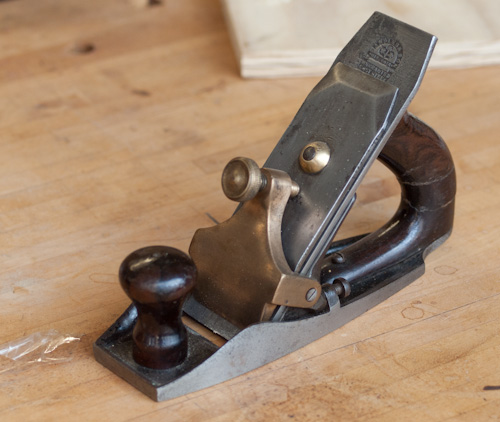 The basic English iron or steel (or as we now call them "infill") smoother plane was first introduced in the late 1840's or 1850's, before Leonard Bailey began manufacturing his iron planes in the US. There is a major difference in philosophy between the basic designs. Bailey had capital and his designs were made to be mass produced. With very little machining, and no skilled production he could bolt together a darn good plane with a lovely mechanical adjuster. English metal planes were designed to keep the basic golden planing of a properly fitted wooden plane, but without the sole wear and issues with wood movement. It took skill to make one of these planes, which meant high cost, and the firms that actually made metal planes in England were small family affairs. The basic English iron or steel (or as we now call them "infill") smoother plane was first introduced in the late 1840's or 1850's, before Leonard Bailey began manufacturing his iron planes in the US. There is a major difference in philosophy between the basic designs. Bailey had capital and his designs were made to be mass produced. With very little machining, and no skilled production he could bolt together a darn good plane with a lovely mechanical adjuster. English metal planes were designed to keep the basic golden planing of a properly fitted wooden plane, but without the sole wear and issues with wood movement. It took skill to make one of these planes, which meant high cost, and the firms that actually made metal planes in England were small family affairs.
The Stanley Rule and Level company in the US was a major firm with lots of resources so after they bought the iron plane designs from Bailey they marketed it aggressively and by the 1880's (maybe a little earlier) their fancy iron planes show up in England.
Most of the planemakers ignored the invasion but Thomas Norris did not. What you have here is an unsuccessful attempt to produce what seems to be as a budget "Norris" from easy to make castings. It is certainly possible to suggest that this plane is an example of Norris's attempts at innovation of which the 1913 adjuster many years later was the most successful example.
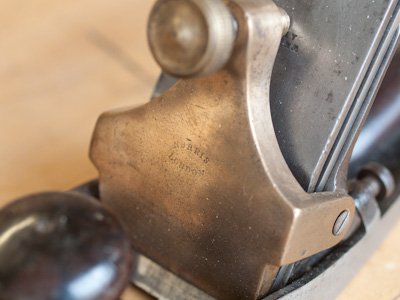 This particular plane came from the David Russell collection and he had several, including one marked "Musgrave" and another marked "Buck", companies that Norris made planes for. This suggests that while the design was certainly unsuccessful commercially, and Russell suggests that the planes were experimental models, there were enough hopes for the design to make a few for potential wholesale customers. Russell suggests a date of the 1880s with a question mark. This particular plane came from the David Russell collection and he had several, including one marked "Musgrave" and another marked "Buck", companies that Norris made planes for. This suggests that while the design was certainly unsuccessful commercially, and Russell suggests that the planes were experimental models, there were enough hopes for the design to make a few for potential wholesale customers. Russell suggests a date of the 1880s with a question mark.
The iron and cap iron in the plane are replacements and the cap iron doesn't fit properly. Of the three planes in the Russell collection this one is the only one with positioning screws mounted on the casting behind the frog. And this brings us to the most important feature of the plane - a removable, adjustable frog. The main reason for having an adjustable frog isn't for the user to adjust for different woods. That's just marketing hype. Wooden planes didn't have adjustable mouths, and of the hundreds of Stanley planes I have looked at over the years none show any signs of having a frog that was regularly adjusted. But it makes manufacturing the plane far, far easier. Suddenly you don't need a precisely milled sole, because the mouth is set later, and machining the sole and the frog separately becomes a much simpler 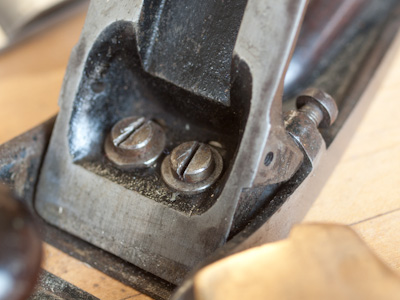 proposition. And the castings are more consistent in section and that gives a more stable casting which is less likely to move. proposition. And the castings are more consistent in section and that gives a more stable casting which is less likely to move.
This sample has a cracked handle but I used it a bit. It works, it works well. Does it work as well as my well turned Bedrock, let's just say I'm not switching any time soon. Does it work as well as a standard dovetailed Norris infill - no chance. The thick iron, and the short overall length ( 7 7/8" with a 2 1/4" iron) make is a better smoother than the longer Stanley, but without an adjuster it's no contest which one I prefer.
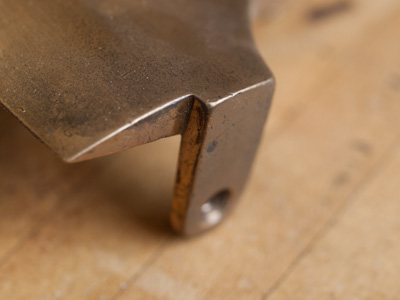 Twenty years or so later Norris solved the adjuster problem but by that time Bailey style planes were firmly established in England and competing against them made no sense. Both Spiers and Norris made lower priced plane lines but neither was particularly successful at it. Norris took a different track in the 1920's and decided not to play the game. While still making some lower end planes they concentrated on their high end and the top of the line Norris planes from the 1920's get better and better. Twenty years or so later Norris solved the adjuster problem but by that time Bailey style planes were firmly established in England and competing against them made no sense. Both Spiers and Norris made lower priced plane lines but neither was particularly successful at it. Norris took a different track in the 1920's and decided not to play the game. While still making some lower end planes they concentrated on their high end and the top of the line Norris planes from the 1920's get better and better.
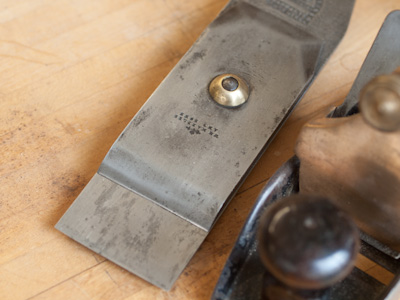
|
 Joel's Blog
Joel's Blog Built-It Blog
Built-It Blog Video Roundup
Video Roundup Classes & Events
Classes & Events Work Magazine
Work Magazine


 The basic English iron or steel (or as we now call them "infill") smoother plane was first introduced in the late 1840's or 1850's, before Leonard Bailey began manufacturing his iron planes in the US. There is a major difference in philosophy between the basic designs. Bailey had capital and his designs were made to be mass produced. With very little machining, and no skilled production he could bolt together a darn good plane with a lovely mechanical adjuster. English metal planes were designed to keep the basic golden planing of a properly fitted wooden plane, but without the sole wear and issues with wood movement. It took skill to make one of these planes, which meant high cost, and the firms that actually made metal planes in England were small family affairs.
The basic English iron or steel (or as we now call them "infill") smoother plane was first introduced in the late 1840's or 1850's, before Leonard Bailey began manufacturing his iron planes in the US. There is a major difference in philosophy between the basic designs. Bailey had capital and his designs were made to be mass produced. With very little machining, and no skilled production he could bolt together a darn good plane with a lovely mechanical adjuster. English metal planes were designed to keep the basic golden planing of a properly fitted wooden plane, but without the sole wear and issues with wood movement. It took skill to make one of these planes, which meant high cost, and the firms that actually made metal planes in England were small family affairs. This particular plane came from the David Russell collection and he had several, including one marked "Musgrave" and another marked "Buck", companies that Norris made planes for. This suggests that while the design was certainly unsuccessful commercially, and Russell suggests that the planes were experimental models, there were enough hopes for the design to make a few for potential wholesale customers. Russell suggests a date of the 1880s with a question mark.
This particular plane came from the David Russell collection and he had several, including one marked "Musgrave" and another marked "Buck", companies that Norris made planes for. This suggests that while the design was certainly unsuccessful commercially, and Russell suggests that the planes were experimental models, there were enough hopes for the design to make a few for potential wholesale customers. Russell suggests a date of the 1880s with a question mark.  proposition. And the castings are more consistent in section and that gives a more stable casting which is less likely to move.
proposition. And the castings are more consistent in section and that gives a more stable casting which is less likely to move.  Twenty years or so later Norris solved the adjuster problem but by that time Bailey style planes were firmly established in England and competing against them made no sense. Both Spiers and Norris made lower priced plane lines but neither was particularly successful at it. Norris took a different track in the 1920's and decided not to play the game. While still making some lower end planes they concentrated on their high end and the top of the line Norris planes from the 1920's get better and better.
Twenty years or so later Norris solved the adjuster problem but by that time Bailey style planes were firmly established in England and competing against them made no sense. Both Spiers and Norris made lower priced plane lines but neither was particularly successful at it. Norris took a different track in the 1920's and decided not to play the game. While still making some lower end planes they concentrated on their high end and the top of the line Norris planes from the 1920's get better and better. 